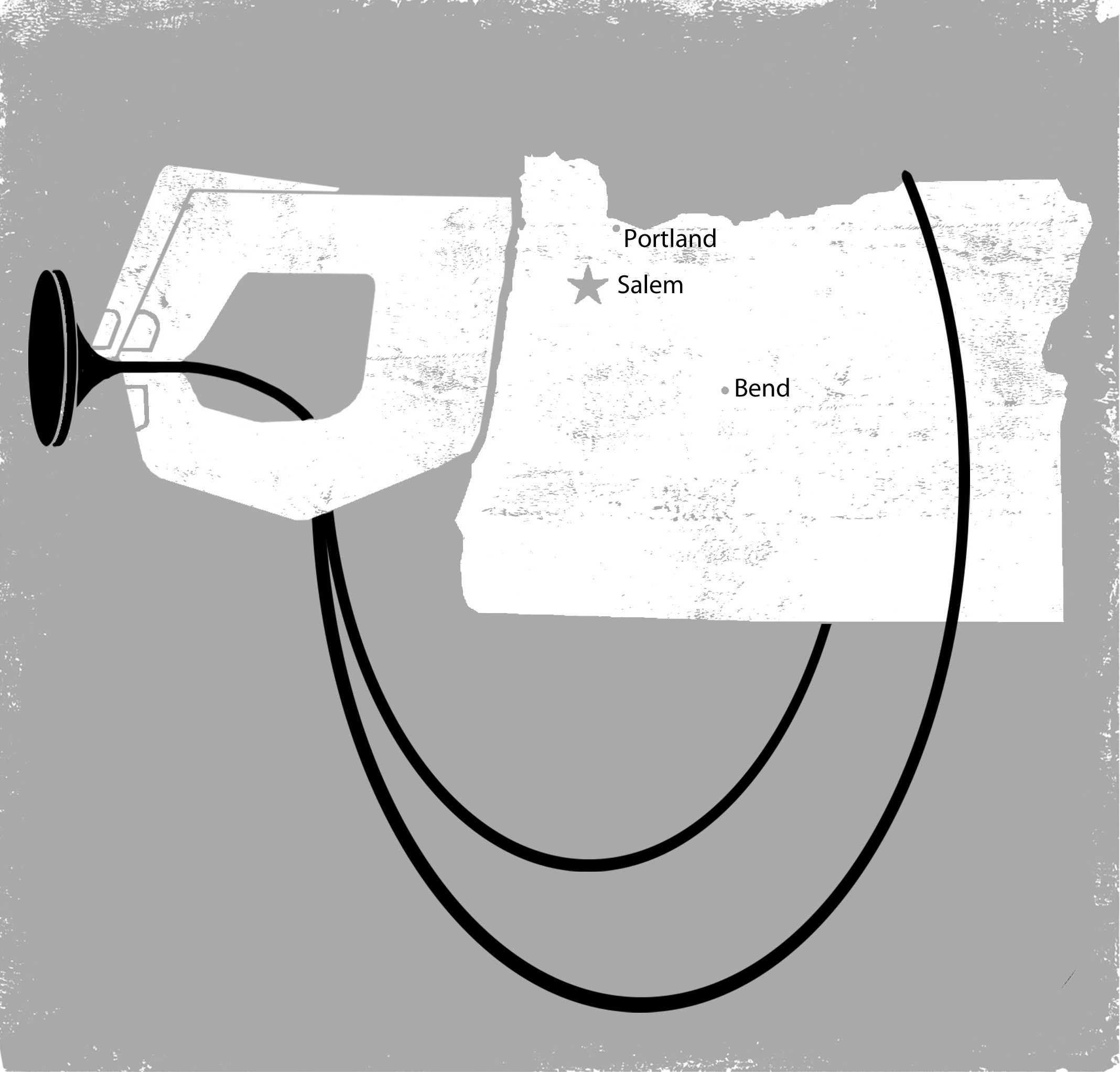(Illustration by Edel Rodriguez for the Spectator)
Around october 1, more than a quarter-million low-income Oregonians received a life-changing letter in the mail. The state’s Medicaid director wrote to tell them they were eligible for coverage, without having to apply. Through this “fast-track” letter, 56,000 people—one-tenth of the state’s uninsured population—were enrolled in the Oregon Health Plan by October 17.
Oregon has worked for decades to improve Medicaid access and how it delivers care. But what it is doing in the Obamacare era is extraordinary.
| Oregon has worked for decades to improve Medicaid access and how it delivers care. But what the state and its governor John Kitzhaber are doing in the Obamacare era is extraordinary. |
Under third-term Democratic Governor John Kitzhaber, Oregon began transforming its Medicaid program last summer by dividing the state into regional coordinated care organizations (CCOs); each one receives a slice of the Medicaid budget it is allowed to spend flexibly. The CCOs are not paid in full unless they demonstrate good outcomes. They emphasize prevention, with health-care providers even making house calls to keep patients on track. Beyond house calls, the medical services they provide are often unconventional. Kitzhaber’s favorite example: a CCO could purchase and install a $200 air conditioner in an elderly woman’s home, preventing an expensive heart failure flareup that could result in tens of thousands of dollars spent in a hospital. The CCOs combine mental, physical and dental care, and they promote teamwork over hierarchy (it helps that Oregon’s nurse practitioners have independent prescribing powers). Their boards are required to include community members.
“The conversations are no longer about money, they’re no longer about power, they’re less about ego and who has the right answer,” says Brenda Johnson, board president of the Jackson Care Connect CCO. Instead, they’re about “what’s the right thing to do right now for the people of this community.”
The CCOs became law in 2011 with strong bipartisan support. They built on decades of healthcare reform, much of it driven by Kitzhaber. In 1987, Oregon’s Legislature prioritized prenatal care over organ transplants for Medicaid recipients. Two years later, Kitzhaber, an emergency room doctor turned state senator, sponsored a plan to insure all needy Oregonians.
Launched in 1994, the Oregon Health Plan became the country’s first public insurance plan to ration health care by delineating services it would and wouldn’t pay for. This utilitarian approach allowed Oregon to offer Medicaid to everyone below the federal poverty line, though that achievement was soon vitiated by budget cuts. Kitzhaber was elected governor in 1995 and held office until 2003. In 2010, he was elected to a third term, and he returned to his health care agenda.
Last May, when a budget shortfall threatened the 2011 reforms, Kitzhaber struck a bargain with the federal government. If the feds would lend the state $1.9 billion over five years, Oregon would establish its CCOs and commit to a “triple aim” program of cost containment, higher-quality care, and better health. That means holding down the rate of cost growth while reducing medical errors, coordinating care, and delivering other improvements, all of which the state estimates will save $11 billion over a decade. It’s an immense task and a risky one, because if Medicaid costs do outstrip the budget, the Legislature will have to find the money to cover patients’ benefits and doctor bills. But Oregon has worked wonders before: between 2008 and 2011, it reduced its uninsured population even as poverty rates climbed.
Why is Oregon a Mecca for health reform? Its Pacific Northwest culture places a premium on cooperation and on caring for the vulnerable. Its lawmakers are comfortable with bipartisanship, as is the long-serving Kitzhaber.
The governor also enjoys the respect of the medical community: According to Dr. Nicholas Gideonse, medical director of a primary care clinic at the Oregon Health & Science University, “he’s definitely seen as an honest broker.” The state’s robust managed-care network hasn’t hurt either; many of its managed-care organizations morphed into CCOs with relative ease.
Perhaps more important, Oregon’s executive and legislative branches put Washington to shame by repeatedly addressing failure with pragmatism, teamwork, and a willingness to do something. When budget restrictions threatened the Oregon Health Plan’s aim to extend coverage to everyone up to 185 percent of the poverty line, the 2003 Legislature came up with stripped-down coverage for single people to lower program costs.
When federal and state matching funds could only cover 10,000 new Medicaid enrollees in 2008, the state created a lottery to allocate the spaces to 90,000 qualified applicants. Now, with Medicaid expansion funding provided by the Affordable Care Act, coverage will be extended to most of those who didn’t make the cut in 2008.
Payments are a challenge. Though CCOs can choose how to spend their Medicaid money, they’re still stuck with fee-for-service billing. Fee-for-service pays providers for individual services like clinic visits or surgical procedures, whether or not the patient’s health actually improves. CCOs are experimenting with flexible benefits, using emails or community health workers in place of clinic visits and buying things like a cab ride to the clinic, a vacuum cleaner for the family of an asthmatic child, or shoes for a homeless man with foot ulcers. But those aren’t “covered benefits” and they can complicate billing. In a pilot project, three community health centers are working to ditch Medicaid fee-for-service almost entirely in favor of a per-member-per-month payment, allowing them more freedom to keep patients healthy rather than treating them when they become ill.
Hopes are high for the newest version of Kitzhabercare.
Janet Meyer, head of the Portland CCO Health Share, says she worries about satisfying newly insured people who might expect “streets paved in gold.” But she’s confident Health Share can limit costs and deliver better outcomes. And some early CCO data are promising: fewer emergency room visits, fewer hospital admissions for adults with asthma or with heart failure, and costs that are largely inching downward.
Uninsured people already use the health care system, albeit inefficiently, Meyer said.
“Catching them before they’re catastrophic, caring for them when you have a chance to change the trajectory of their health care status—why wouldn’t you do that?”
Jenny Blair is a writer and MD.




0 Comments